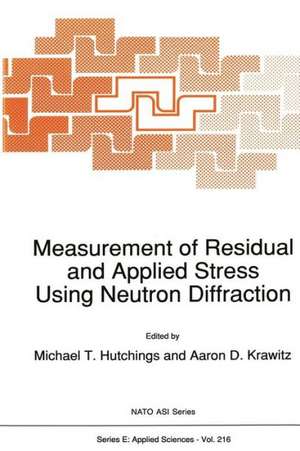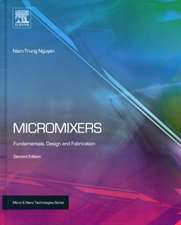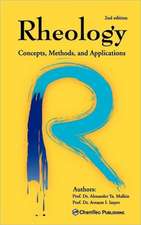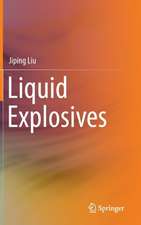Measurement of Residual and Applied Stress Using Neutron Diffraction: NATO Science Series E:, cartea 216
Editat de M.T. Hutchings, Aaron D. Krawitzen Limba Engleză Paperback – 9 noi 2012
Din seria NATO Science Series E:
- 24%
 Preț: 1570.65 lei
Preț: 1570.65 lei -
 Preț: 397.76 lei
Preț: 397.76 lei -
 Preț: 386.81 lei
Preț: 386.81 lei - 20%
 Preț: 346.24 lei
Preț: 346.24 lei -
 Preț: 424.33 lei
Preț: 424.33 lei - 18%
 Preț: 1224.18 lei
Preț: 1224.18 lei - 18%
 Preț: 1836.63 lei
Preț: 1836.63 lei - 18%
 Preț: 1229.28 lei
Preț: 1229.28 lei -
 Preț: 381.00 lei
Preț: 381.00 lei -
 Preț: 409.30 lei
Preț: 409.30 lei - 18%
 Preț: 1841.36 lei
Preț: 1841.36 lei - 5%
 Preț: 367.28 lei
Preț: 367.28 lei -
 Preț: 407.19 lei
Preț: 407.19 lei - 18%
 Preț: 1838.38 lei
Preț: 1838.38 lei -
 Preț: 420.28 lei
Preț: 420.28 lei -
 Preț: 399.29 lei
Preț: 399.29 lei -
 Preț: 398.74 lei
Preț: 398.74 lei - 18%
 Preț: 3026.13 lei
Preț: 3026.13 lei -
 Preț: 388.90 lei
Preț: 388.90 lei - 5%
 Preț: 391.06 lei
Preț: 391.06 lei - 18%
 Preț: 1228.62 lei
Preț: 1228.62 lei - 18%
 Preț: 1229.73 lei
Preț: 1229.73 lei - 18%
 Preț: 1234.46 lei
Preț: 1234.46 lei - 5%
 Preț: 3532.05 lei
Preț: 3532.05 lei - 18%
 Preț: 1840.11 lei
Preț: 1840.11 lei - 5%
 Preț: 378.80 lei
Preț: 378.80 lei - 18%
 Preț: 1227.84 lei
Preț: 1227.84 lei -
 Preț: 392.75 lei
Preț: 392.75 lei -
 Preț: 395.63 lei
Preț: 395.63 lei - 18%
 Preț: 2489.30 lei
Preț: 2489.30 lei - 5%
 Preț: 1429.27 lei
Preț: 1429.27 lei -
 Preț: 396.02 lei
Preț: 396.02 lei - 5%
 Preț: 2142.61 lei
Preț: 2142.61 lei - 18%
 Preț: 3049.16 lei
Preț: 3049.16 lei - 18%
 Preț: 1844.54 lei
Preț: 1844.54 lei -
 Preț: 403.53 lei
Preț: 403.53 lei
Preț: 406.25 lei
Nou
Puncte Express: 609
Preț estimativ în valută:
77.76€ • 80.87$ • 65.16£
77.76€ • 80.87$ • 65.16£
Carte tipărită la comandă
Livrare economică 13-27 martie
Preluare comenzi: 021 569.72.76
Specificații
ISBN-13: 9789401052429
ISBN-10: 9401052425
Pagini: 612
Ilustrații: XVIII, 588 p.
Dimensiuni: 160 x 240 x 32 mm
Greutate: 0.84 kg
Ediția:Softcover reprint of the original 1st ed. 1992
Editura: SPRINGER NETHERLANDS
Colecția Springer
Seria NATO Science Series E:
Locul publicării:Dordrecht, Netherlands
ISBN-10: 9401052425
Pagini: 612
Ilustrații: XVIII, 588 p.
Dimensiuni: 160 x 240 x 32 mm
Greutate: 0.84 kg
Ediția:Softcover reprint of the original 1st ed. 1992
Editura: SPRINGER NETHERLANDS
Colecția Springer
Seria NATO Science Series E:
Locul publicării:Dordrecht, Netherlands
Public țintă
ResearchCuprins
Workshop Papers.- 1. Overview.- ‘Neutron Diffraction Measurement of Residual Stress Fields: Overview and Points for Discussion’.- 2. Background.- ‘Role of Neutron Diffraction in Engineering Stress Analysis’.- ‘Applications of X-ray Residual Stress Measurements in Industrial R&D’.- ‘The Theory of Stress/Strain Analysis with Diffraction’.- ‘The Calculation of Residual Stress’.- ‘Comparison Between Finite Element Calculations and Neutron Diffraction Measurements of Residual Stress in a Diametrically Compressed Ring’.- 3. Aspects of Fundamental Principles.- ‘Macrostresses, Microstresses and Stress Tensors’.- ‘Separation of Microstresses and Macrostresses’.- ‘The Effects of Crystalline Anisotropy on the Elastic Response of Materials’.- ‘Investigation of Large Grained Samples - Principles’.- ‘The Plastic Regime, Including Anisotropy Effects’.- ‘Grain Interaction Stresses’.- ‘Relaxation’.- ‘Interpretation of Residual Stress Measurements: Summary of Discussion Session’.- 4. Aspects of Experimental Measurement.- ‘Spatial Resolution and Strain Scanning’.- ‘Strain Tensor Measurements by Neutron Diffraction’.- ‘Investigations of Large Grained Samples - Examples’.- ‘The Stress-free Reference Sample: Alloy Composition Information from Neutron Capture’.- ‘The Precision of Peak Position Determination in Diffraction Measurements of Stress’.- ‘Errors in Analysis’.- 5. Instrumentation.- 5a Instrumentation: Steady State Reactor.- ‘Optimised Geometry for a Stress Measurement Two-axis Diffractometer at a Reactor’.- ‘Implementation and Application of a Psd Set-Up for Neutron Diffraction Strain Measurements’.- ‘Reverse Time-of-Flight Fourier Technique for Strain Measurements’.- ‘The Alignment ofInstrumentation and the Positioning of Specimens for Stress Measurements by Means of Neutron Diffraction’+.- ‘Proposal for a Neutron Strain Measurement Apparatus’+.- ‘Microbeam Techniques in Diffraction: A Theoretical Treatment’.- ‘Summary of the Panel Discussion on Instrumentation at Steady State Sources’.- 5b Instrumentation; Pulsed Neutron Source.- ‘Residual and Applied Stress Measurements at Ipns’.- ‘Residual Stress Measurement Using the Pulsed Neutron Source at Lansce’.- ‘Stress Measurement: Experience at Isis’.- ‘Transmission Bragg-Edge Measurements’.- ‘Macs, The Manipulation and Collimation System on the NPD at Lansce’+.- ‘The Design of a Pulsed Source Instrument: Summary of Discussion Session’.- 6. Composites.- ‘Stress Measurements in Composites Using Neutron Diffraction’.- ‘Theory and Modelling of Composites’.- ‘Application of Neutron Diffraction Time-of-Flight Measurements to the Study of Strain in Composites’.- ‘Deformation Analysis in Mixed Composites’.- ‘Surface and Near-surface Analysis of Residual Stresses in Aluminium and Titanium Alloys - Examples of the Case for X-ray Diffraction’.- ‘Residual Stresses in Brazed Ceramic-metal Compounds’.- 7. Measurements on Bulk Components.- ‘Residual Stress Distribution in Cracked Autofrettaged Tubing’.- ‘Measurement of Stresses in Metal Adhesive Joints’.- ‘Residual Stress Measurements in Armament-related Components’.- ‘Problems with Railway Rails’+.- ‘Neutron Measurements of Residual Strain in Some Technological Materials and Components’+.- ‘Development of the Neutron Diffraction Technique for the Determination of Near Surface Residual Stresses in Critical Gas Turbine Components’+.- ‘Residual Stresses at Cold Expanded FastenerHoles’+.- ‘Neutron and X-ray Diffraction Residual Stress Measurements on Power Generator Turbine Blades: Comparison with Finite Element Analysis’.- 8. Comparison of Neutrons with X-Rays and Other Stress Probes.- ‘Calibration of Portable NDE Techniques for Residual Stress Measurement’.- ‘Triaxial Analysis of Residual Stress Fields in Metallic Plates’+.- ‘Pitfalls of Layer Removal Techniques in X-ray Residual Stress Measurements’.- ‘Neutrons Versus X-rays’.









